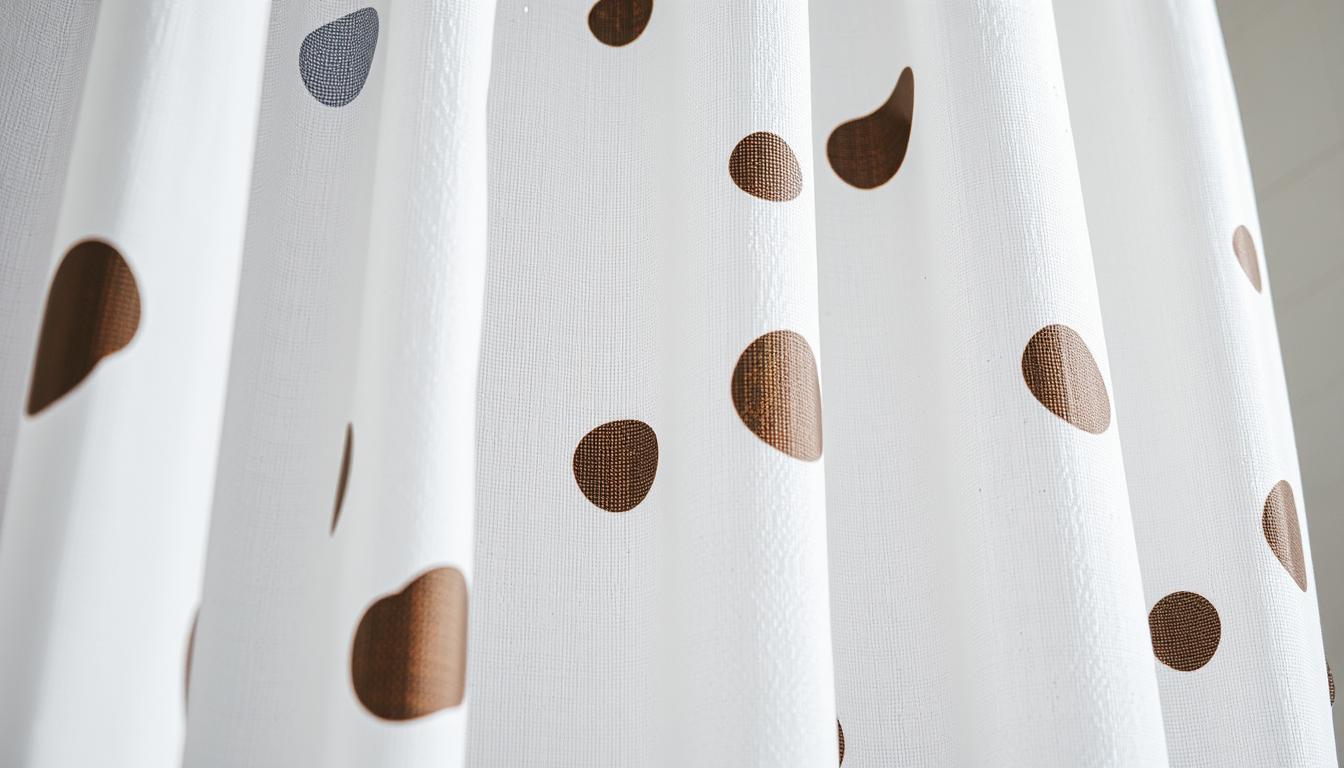Black Spots on Shower Curtain: Causes and Solutions
Black spots on your shower curtain mean mold and mildew might be growing. This is not just ugly but can also be bad for your health. These spots love places that are humid, dark, and full of body soils.
Before you think about throwing it away, know that you can clean it. You can use vinegar, baking soda, Borax, hydrogen peroxide, and chlorine bleach for this. The best method depends on what your curtain is made of and how much mold is there. Make sure the curtain dries completely after cleaning to avoid more mold.
Seeing mold on your curtain can also mean your bathroom needs more care. This could be a sign to start using preventive measures and regular cleaning.
Why Does My Shower Curtain Have Black Spots?
Have you noticed black spots on your shower curtain? This is often a sign of mold or mildew. These fungi love damp places like your bathroom. It’s important to deal with them because they can be harmful to your health.
Identifying Mold and Mildew on Shower Curtains
First, you need to identify if it’s really mold on your bathroom shower. Mold and mildew look like slimy black, gray, or pink spots and smell musty. Catching them early, when they are tiny, is key. This makes cleaning them off with detergent much easier. Mold spores can stick deep in fabric curtains, which makes them tough to get rid of.
Factors Contributing to Mold and Mildew Growth
Mold grows well in humid places, where humidity is between 35% and 50%. If your bathroom isn’t well-ventilated, moisture sticks around, promoting mold. Not cleaning your shower curtain or leaving it wet can make things worse. Dr. Brown recommends cleaning your liner weekly and drying it after each use to stop mold.
Choosing a cotton shower curtain might sound nice, but it can actually lead to more mold because cotton holds moisture. Deep cleaning weekly helps, and so does keeping the bathtub area clean to give mold less to feed on. Closing the toilet lid when you flush is a good habit, too. It stops toilet water mist, which can reach your shower curtain, up to six feet away.
- Dr. Brown advises replacing shower curtain liners every six months to a year.
- Spray bathroom cleaner on the liner weekly.
- Dry shower curtain after each use.
- Keep humidity levels between 35% and 50%.
How to Remove Mold from Shower Curtain
To get rid of mold on shower curtains, it’s key to know the type you have. Whether it’s plastic or cloth, using the right cleaning method and natural solutions is vital. This approach helps in removing and preventing mold.
Cleaning Methods for Plastic Shower Curtains
Cleaning plastic shower curtains offers a few options. One way is mixing bleach with water in a 1:1 ratio for spots. It’s important to use bleach safely, without mixing it with other cleaners to avoid harmful gases.
Another technique uses baking soda. Put 1 to 2 tablespoons of baking soda on a moist sponge. When cleaning in the washing machine, use warm water and a bit of laundry detergent. This method, along with a rinse, can clean without harming the plastic.
Cleaning Methods for Cloth Shower Curtains
Cloth curtains need gentle care, especially if they’re made of natural fibers. Start by treating mildew spots before washing. Washing should be gentle, with warm water and a little detergent. Washing cloth curtains weekly can prevent mold from taking hold.
Cloth curtains’ weave makes them a mold target. But washing them every week can keep mold at bay.
Natural Cleaning Solutions
Natural solutions are a greener choice for cleaning. Vinegar and baking soda can tackle mold on curtains well. Mix vinegar and water in equal parts for a soak that stops mold. Then, use baking soda for scrubbing away mold and stains.
For lots of mold, soaking in vinegar or oxygen bleach works well. Remember to air-dry curtains after cleaning to keep mold away.
| Cleaning Method | Plastic Shower Curtain | Cloth Shower Curtain |
|---|---|---|
| Spot Cleaning Solution | 1:1 bleach and water | Stain remover pre-treatment |
| Washing Process | Warm water cycle with less than 1 tbsp detergent | Gentle cycle with warm water and minimal detergent |
| Natural Cleaning Solutions | 1-2 tbsp baking soda scrub | Vinegar and baking soda mixture |
| Post-Cleaning Steps | Air-dry to prevent mildew | Air-dry to avoid recurrence |
Preventing Shower Curtain Mold and Mildew
To stop mold and mildew on your shower curtain, make your bathroom a tough place for mold to grow. It’s about better airflow, cleaning often, and choosing curtains that resist mildew. This way, mold won’t easily find a home in your bathroom.
Improving Bathroom Ventilation
Good airflow is a top way to keep mold away. Use exhaust fans and open windows when you can. This keeps the air moving and the moisture down. Both are key to stopping mold from growing on your shower curtain.
Don’t forget to spread out the curtain after showering. Swipe off extra water with a squeegee too. Keeping things dry keeps the mold away. Check out how to prevent shower curtain mold for more tips.
Regular Cleaning Schedule
Sticking to a cleaning plan helps fight mold. Experts say to wash your curtain, liner, and rings monthly. Plus, spray your liner with cleaner every week. This keeps mildew at bay.
When you shower next, rinse off any leftover cleaner. A good scrub weekly will also get rid of soap build-up. It’s all about keeping things clean and dry.
| Cleaning Schedule | Action |
|---|---|
| Daily | Spread shower curtain to dry, use a squeegee |
| Weekly | Spray with water-vinegar solution, deep clean bathroom |
| Monthly | Wash curtain, liner, rings, and shower rod |
Using Mildew-Resistant Shower Curtains
Mildew-resistant curtains are a great pick. But they still need your care. Regular cleanings and good airflow make them last. Together, these steps work best for a mold-free bathroom.
Shower Curtain Cleaning Tips
Keeping your shower curtain clean stops mold and mildew from growing. A top cleaning tip is to mix vinegar with water in a spray bottle. Use a 1-to-4 ratio. After spreading the shower curtain out, spray the mix on the inner side. Then, rinse it off with warm water.
To wash fabric curtains in a machine, use the gentle cycle. Also, use warm water and a soft detergent. When cleaning plastic or fabric curtains, throw in towels. They help scrub the curtain and soak up excess water.
In warm or damp places, using vinegar beforehand can keep things cleaner. Also, tossing in baking soda and vinegar during the rinse cycle fights against mildew. Making this a weekly habit can prevent mold and foul smells.
For those who prefer green cleaning solutions, try oxygen bleach. It’s less harsh than other chemicals. Don’t use chlorine bleach on dark materials; it can cause fading. Natural cleansers like baking soda and lemon juice are great for tough stains. They also won’t harm your curtains.
After washing, make sure your curtain and liner dry completely. This stops mold from growing. Swapping your shower curtains each month also helps. Below, find extra tips to keep your shower curtain looking new:
| Cleaning Method | Fabric Curtains | Plastic Curtains |
|---|---|---|
| Machine Wash | Hand wash with mild detergent on a gentle cycle | Cold water wash with towels to reduce wrinkles |
| Hand Cleaning | Soak in warm water with baking soda and mild detergent | Fill the tub with warm water, add baking soda, gently agitate, rinse, and air dry |
| Extra Steps | Include light-colored towels for extra scrubbing action | Using vinegar and baking soda in a monthly wash cycle |
Having a regular shower curtain maintenance routine keeps your bathroom clean and healthy. It also stops the nasty buildup of soap scum and mildew.
Safety Precautions When Dealing with Mold
When you find mold at home, safety is key, especially with moldy shower curtains. Bathrooms are perfect for mold because they are moist, warm, and have organic materials. It’s important to choose safe cleaning products and know how to handle and get rid of moldy stuff properly.
Choosing the Right Cleaning Products
Choosing the right cleaners means looking at how well they work and if they’re safe. You might pick strong cleaners like chlorine bleach or gentler ones like hydrogen peroxide or borax. These are better for the environment and for you. It’s essential to pick a cleaner that works well but is also safe. The Wisconsin Department of Health Services has great tips on choosing safe and effective cleaning products.
Proper Handling and Disposal of Moldy Shower Curtains
Getting rid of moldy shower curtains the right way stops mold from spreading. Make sure to wear gloves and masks to block skin contact and breathing in mold spores. Mold spores can cause allergies and breathing problems. Put the moldy curtain in a plastic bag before throwing it away to avoid spreading mold spores. Having good air flow in your bathroom when doing this is also important to lower mold exposure risk.
It’s very important to follow these safety steps when dealing with mold to keep your home healthy. To learn more and get advice on preventing and treating mold, check out resources from Cover Advice. They can help you understand how to safely deal with different materials.

Hey there, I’m Alex Hanson and I’m passionate about all things covers! Whether you’re looking for a car seat cover to protect your vehicle or an oven cover to keep your kitchen clean, I’m here to help. With years of experience in the industry, I have plenty of knowledge and insights to share with my readers. So, if you care about protecting your belongings and making them look their best, you’re encouraged to read my blog as I explore the perfect cover for every need.







